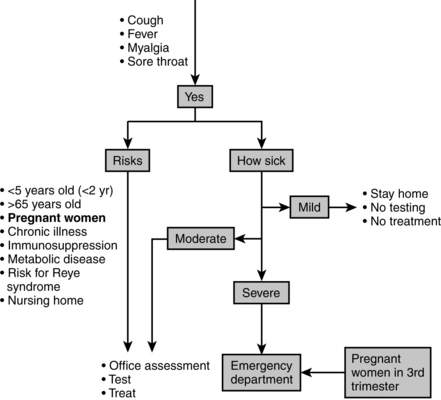Chapter 39 Influenza
4 Who is at risk for more severe or complicated influenza?
 Chronic pulmonary (including asthma), cardiovascular (except hypertension), renal, hepatic, neurologic, hematologic, or metabolic disorders (including diabetes mellitus)
Chronic pulmonary (including asthma), cardiovascular (except hypertension), renal, hepatic, neurologic, hematologic, or metabolic disorders (including diabetes mellitus)
 Immunosuppression caused by medications, organ transplantation, malignancy, or HIV
Immunosuppression caused by medications, organ transplantation, malignancy, or HIV
 Pregnancy during the influenza season
Pregnancy during the influenza season
 Aged 6 months to 18 years and receiving long-term aspirin therapy (Reye syndrome)
Aged 6 months to 18 years and receiving long-term aspirin therapy (Reye syndrome)
 Residents of nursing homes and other long-term–care facilities
Residents of nursing homes and other long-term–care facilities
8 What is the approach to the patient with an ILI?
Those with mild symptoms (no shortness of breath and able to maintain hydration) and no risks for complications do not need further testing and can be treated symptomatically. Those with moderate symptoms (some shortness of breath, difficulty maintaining hydration, signs and symptoms of pneumonia) should be tested and treated with antiviral medications. Those with severe symptoms (respiratory distress, altered mental status) need immediate assessment in the emergency department. Pregnant women with influenza, especially those in the third trimester, have a high rate of complications and should be urgently assessed in the emergency department also. See Figure 39-1.
10 How do you manage a patient admitted to the hospital with ILI?
17 What infection control measures are needed?
 Placing the patient in a private room.
Placing the patient in a private room.
 Wearing a surgical mask when entering the patient room.
Wearing a surgical mask when entering the patient room.
 Wearing gloves and gowns if you should expect contact with patient’s blood, body fluids, or secretions (including respiratory).
Wearing gloves and gowns if you should expect contact with patient’s blood, body fluids, or secretions (including respiratory).
 If participating in an aerosol-generating procedure such as intubation, extubation, bronchoscopy, or autopsy, a fit-tested N95 respirator or a powered air-purifying respirator (PAPR) should be worn.
If participating in an aerosol-generating procedure such as intubation, extubation, bronchoscopy, or autopsy, a fit-tested N95 respirator or a powered air-purifying respirator (PAPR) should be worn.
All health care workers need to practice good hand hygiene before and after patient contact.
18 Who should get the influenza vaccine?
Key Points Influenza
1. Influenza can cause severe respiratory illness requiring ICU care.
2. Influenza may exacerbate underlying cardiopulmonary conditions.
3. All patients admitted to the hospital for presumed influenza should be treated with antiviral medications.
4. Secondary bacterial pneumonias may develop and should be looked for and treated.
5. All persons aged older than 6 months should be vaccinated yearly.
1 Fiore A.E., Fry A., Shay D., et al. Antiviral agents for the treatment and chemoprophylaxis of influenza. Recommendations of the Advisory Committee on Immunization Practices (ACIP). MMWR Recomm Rep. 2011;60:1–24.
2 Girard M.P., Tam J.S., Assossou O.M., et al. The 2009 A (H1N1) influenza virus pandemic: a review. Vaccine. 2010;28:4895–4902.
3 Homsi S., Milojkovic N., Homsi Y. Clinical pathological characteristics and management of acute respiratory distress syndrome resulting from influenza A (H1N1) virus. South Med J. 2010;103:786–790.
4 Kumar A., Zarychanski R., Pinto R., et al. Critically ill patients with 2009 influenza A (H1N1) infection in Canada. JAMA. 2009;302:1872–1879.
5 Tang J.W., Shetty N. Tsan-Yuk Lam T: Features of the new pandemic influenza A/H1N1/2009 virus: virology, epidemiology, clinical and public health aspects. Curr Opin Pulm Med. 2010;16:235–241.









